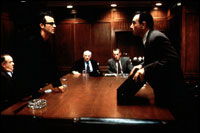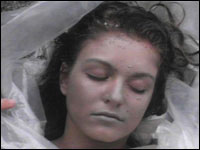Surreal
Violence
 |
|
|
|
Lynch’s Hollywood is mythic and surreal.
The monstrous is married to the absurd. Cruelty and silliness
are coupled. This is particularly revealed in Mulholland’s
surrealist influenced black, burlesque violence. I have noted
that the violence of the car crash demonstrates the surreal
role of chance. Furthermore, motivated violence is often ruptured
by chance. In a sequence in Diane’s dream narrative, a seedy
blonde man is talking to another seedy greasy-haired man who
has been telling the hitman about an incredible but hilarious
accident (“An accident like that...it’s unreal, right ?”).
The accident appears to refer to Rita’s dramatic crash on
Mulholland. The blonde man Joe kills his friend / business
associate and picks up a little black book which appears to
be related to Rita’s attempted murder. (As divulged by a later
scene, we know Joe is after Rita. He asks a junkie prostitute
in Pinks diner : “Any new girl on the street ?
A brunette, maybe a little beat up ?”) The blonde
man’s sudden killing of the greasy-haired man leads to an
amusing and cruel chain reaction of random, violent acts.
As Joe shoots the greasy-haired man, he accidentally wounds
a fat woman in the next office. The hitman then fights the
still very much alive woman and after attempting to strangle
her, finally shoots her. He is then “forced” to kill a janitor
who has witnessed the chaos. Shooting the janitor, Joe sets
off the building’s alarm and sprinklers by also shooting the
unfortunate man’s vacuum cleaner. True to surrealist violence,
the murders become absurd accidents. They are irrational and
profitless. The violent acts exhibited by Adam in his anger
at the controlling moves of the Mafia can also be equated
with surrealist violence in that they are sublimated and reveal
a frustrated impotence. Forced to surrender casting choice
of his lead actress, Adam smashes the movie mafioso’s car
windows in with a golf club and flees. The unfortunate Adam
is not only professionally humiliated but must endure the
sight of his wife in bed with the mullet-haired pool-man.
He responds to his wife’s adultery by opening up her jewellery
box and pouring paint over her jewels. Such an act denotes
a form of sublimated rape. In surrealist film, apparently
wantonly foolish acts of violence are acts of sexual sublimation.
In Bunuel’s other early surrealist classic L’Age d’Or (1930),
the frustrated lover Modot kicks a dog, knocks over a blind
man and slaps his lover’s mother for spilling wine on him.
Thus, Lynchian violence, both funny and cruel and denoting
thwarted male sexual passion, may be likened to such spontaneous,
amusing and sexually confounded surrealist savagery.
Hollywood Imagery and Surreal Scenes
and Objects : The Corpse, The Sex, The Club and the Blue
Box
| |
 |
|
|
To return to her dream directly, Betty flees
from the studio to meet Rita to help her in her quest to retrieve
her identity. The two women go to Diane Selwyn’s apartment.
The darkness to come is horrifically revealed by Betty and
Rita’s discovery of a bloated, decaying corpse in the Diane’s
bedroom. The face is unrecognisable but the hair appears to
be blonde and she is wearing a slip dress. Who is the dead
woman ? In a revelatory yet schizoid earlier moment when
Betty and Rita attempt to discover the latter’s identity,
Betty rings the aforesaid Diane’s apartment. Betty, in reference
to Rita, tells her “Strange to be calling yourself”
to which Rita responds “Maybe it’s not me”. We hear
a woman’s voice on the message machine. Rita tells Betty :
“That’s not me but I know her”. The woman’s
voice is Betty’s. Betty we will see is Diane. She is ringing
herself. The body discovered in Diane Selwyn’s apartment we
will also see in the final “reality sequence” of Mulholland
Drive is that of Diane. She will commit suicide after
her rejection by her successful movie star lover Camilla (the
Rita of this dream), and Hollywood itself. As most famously
celebrated in the blue black image of the beautiful blonde
Laura Palmer in Twin Peaks (1990), the corpse of a beautiful
woman appears to be a favourite image of Lynch. Through such
images, Lynch sustains the surreal bind between death and
eroticism. Notably, it is shortly after their discovery of
the corpse that Rita and Betty have sex.
|